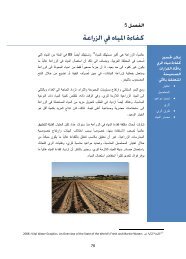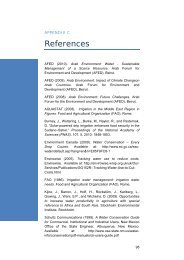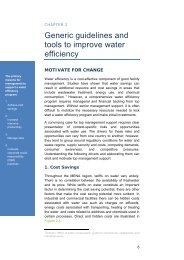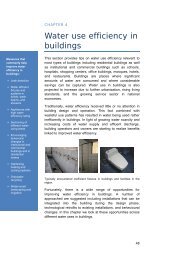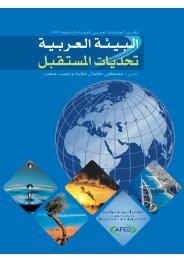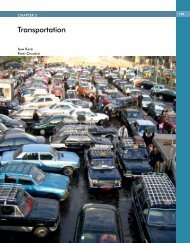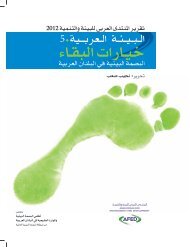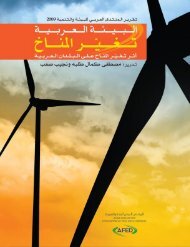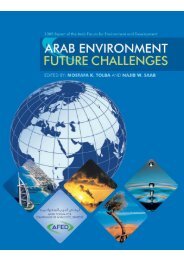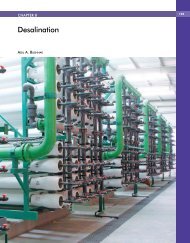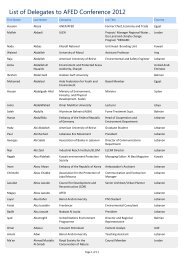Impact of Climate Change on Arab Countries - (IPCC) - Working ...
Impact of Climate Change on Arab Countries - (IPCC) - Working ...
Impact of Climate Change on Arab Countries - (IPCC) - Working ...
Create successful ePaper yourself
Turn your PDF publications into a flip-book with our unique Google optimized e-Paper software.
ARAB ENVIRONMENT: CLIMATE CHANGE 15<br />
Declarati<strong>on</strong> <strong>on</strong> <str<strong>on</strong>g>Climate</str<strong>on</strong>g> <str<strong>on</strong>g>Change</str<strong>on</strong>g>, which c<strong>on</strong>stitutes<br />
the basis for future acti<strong>on</strong> and reflects the<br />
<strong>Arab</strong> positi<strong>on</strong> in dealing with climate change<br />
issues. The declarati<strong>on</strong> stated that “Mitigati<strong>on</strong><br />
programs shall focus <strong>on</strong>: the producti<strong>on</strong> and<br />
use <str<strong>on</strong>g>of</str<strong>on</strong>g> cleaner fuels, improving the efficiency <str<strong>on</strong>g>of</str<strong>on</strong>g><br />
energy use in all sectors, diversifying energy<br />
sources in accordance with the prevailing ec<strong>on</strong>omic<br />
and social c<strong>on</strong>diti<strong>on</strong>s, expanding the use<br />
<str<strong>on</strong>g>of</str<strong>on</strong>g> cleaner producti<strong>on</strong> techniques and envir<strong>on</strong>mental<br />
friendly technologies, as well as expanding<br />
the use <str<strong>on</strong>g>of</str<strong>on</strong>g> ec<strong>on</strong>omic incentives to encourage<br />
more efficient products, al<strong>on</strong>g with speedy<br />
endeavours to c<strong>on</strong>clude negotiati<strong>on</strong>s in the<br />
WTO to define lists <str<strong>on</strong>g>of</str<strong>on</strong>g> envir<strong>on</strong>mental goods so<br />
as to reduce or lift customs restricti<strong>on</strong>s in<br />
accordance, and the utilizati<strong>on</strong> <str<strong>on</strong>g>of</str<strong>on</strong>g> carb<strong>on</strong> trading<br />
and its markets” (CAMRE, 2007).<br />
Currently, CAMRE is leading efforts to develop<br />
an <strong>Arab</strong> climate change acti<strong>on</strong> plan.<br />
II. THE ARAB ENERGY SECTOR<br />
The energy sector in the <strong>Arab</strong> regi<strong>on</strong> has been<br />
and will c<strong>on</strong>tinue to play a critical role in the<br />
regi<strong>on</strong>’s socioec<strong>on</strong>omic development. Oil revenues,<br />
estimated at $419 billi<strong>on</strong> in 2006, have<br />
been the major source <str<strong>on</strong>g>of</str<strong>on</strong>g> income in most <str<strong>on</strong>g>of</str<strong>on</strong>g> the<br />
<strong>Arab</strong> countries, especially in the Gulf regi<strong>on</strong>.<br />
According to the <strong>Arab</strong> Unified Ec<strong>on</strong>omic<br />
Report, the oil and gas sector makes up about<br />
40% <str<strong>on</strong>g>of</str<strong>on</strong>g> the total <strong>Arab</strong> GDP. The same report<br />
estimated that <strong>Arab</strong> countries hold nearly 58% <str<strong>on</strong>g>of</str<strong>on</strong>g><br />
the world’s oil reserves, and nearly 30% <str<strong>on</strong>g>of</str<strong>on</strong>g> the<br />
world’s gas reserves. In 2006, the regi<strong>on</strong> accounted<br />
for nearly 32% <str<strong>on</strong>g>of</str<strong>on</strong>g> the world’s oil producti<strong>on</strong>,<br />
and 12.5% <str<strong>on</strong>g>of</str<strong>on</strong>g> the world’s gas producti<strong>on</strong> (LAS,<br />
2007). The <strong>Arab</strong> countries rely heavily <strong>on</strong> oil and<br />
gas to meet domestic energy demand, they both<br />
account for nearly 97.5% <str<strong>on</strong>g>of</str<strong>on</strong>g> the total <strong>Arab</strong> energy<br />
c<strong>on</strong>sumpti<strong>on</strong>. The average per capita energy<br />
c<strong>on</strong>sumpti<strong>on</strong> level in the <strong>Arab</strong> countries (nearly<br />
1.5 t<strong>on</strong>nes <str<strong>on</strong>g>of</str<strong>on</strong>g> oil equivalent, or TOE) lies<br />
between some developing countries such as<br />
China (1.3 TOE), India (0.5 TOE), and Brazil<br />
(1.1 TOE), and some developed ec<strong>on</strong>omies such<br />
as the US (7.2 TOE), Japan (4.3 TOE), and<br />
Australia (5.8 TOE). There are remarkable disparities<br />
in per capita energy c<strong>on</strong>sumpti<strong>on</strong><br />
am<strong>on</strong>gst different <strong>Arab</strong> countries depending<br />
mainly <strong>on</strong> income levels, standard <str<strong>on</strong>g>of</str<strong>on</strong>g> living,<br />
degree <str<strong>on</strong>g>of</str<strong>on</strong>g> urbanizati<strong>on</strong> and climatic c<strong>on</strong>diti<strong>on</strong>s.<br />
The figure ranges from as low as 0.33 TOE in<br />
Yemen to as high as 22.07 TOE in Qatar (IEA,<br />
2008).<br />
Industry is the major energy c<strong>on</strong>suming sector in<br />
the <strong>Arab</strong> countries, accounting for about 45% <str<strong>on</strong>g>of</str<strong>on</strong>g><br />
the total c<strong>on</strong>sumpti<strong>on</strong> followed by the transport<br />
sector (32%). The residential, commercial and<br />
agricultures sectors make up the rest. This pattern<br />
<str<strong>on</strong>g>of</str<strong>on</strong>g> energy c<strong>on</strong>sumpti<strong>on</strong> determines the<br />
major sources <str<strong>on</strong>g>of</str<strong>on</strong>g> the GHG emissi<strong>on</strong>s, and in<br />
many instances identifies the policy priorities and<br />
measures needed to reduce such emissi<strong>on</strong>s.<br />
Measures to mitigate GHG emissi<strong>on</strong>s<br />
Measures to mitigate GHG emissi<strong>on</strong>s include<br />
those which reduce GHG emissi<strong>on</strong>s from different<br />
anthropogenic activities as well as those<br />
which enhance carb<strong>on</strong> sinks. Major sources <str<strong>on</strong>g>of</str<strong>on</strong>g><br />
GHG emissi<strong>on</strong>s are the energy sector, industrial<br />
sector, and the agriculture sector. In the energy<br />
sector, measures to mitigate GHG emissi<strong>on</strong>s<br />
cover the supply and demand sides. Measures in<br />
the supply side include energy efficiency in<br />
power generati<strong>on</strong> and oil refining, use <str<strong>on</strong>g>of</str<strong>on</strong>g> combined<br />
heat and power to produce electricity and<br />
water, fuel switching away from carb<strong>on</strong> fuels,<br />
electricity imports though regi<strong>on</strong>al electricity<br />
networks, reducti<strong>on</strong> <str<strong>on</strong>g>of</str<strong>on</strong>g> losses in transmissi<strong>on</strong> and<br />
distributi<strong>on</strong>, and power generati<strong>on</strong> using renewable<br />
energy resources such as wind and solar.<br />
On the demand side, measures to improve energy<br />
efficiency in the major c<strong>on</strong>suming sectors such<br />
as industry, transport, and residential and commercial<br />
sectors, include efficient lighting systems,<br />
improving efficiency <str<strong>on</strong>g>of</str<strong>on</strong>g> cooling and refrigerati<strong>on</strong>,<br />
combusti<strong>on</strong> efficiency improvements, recovery <str<strong>on</strong>g>of</str<strong>on</strong>g><br />
waste heat, and many others.<br />
These measures include improving energy efficiency<br />
throughout the ec<strong>on</strong>omy, diversifying<br />
away from fossil fuels, and promoting the use <str<strong>on</strong>g>of</str<strong>on</strong>g><br />
renewable energy alternatives. The nati<strong>on</strong>al communicati<strong>on</strong><br />
reports listed a set <str<strong>on</strong>g>of</str<strong>on</strong>g> planned projects<br />
in the energy supply sectors. These are related<br />
primarily to more efficient producti<strong>on</strong> and a<br />
wider adopti<strong>on</strong> <str<strong>on</strong>g>of</str<strong>on</strong>g> renewable sources. Some <str<strong>on</strong>g>of</str<strong>on</strong>g><br />
the projects proposed were to evaluate the market<br />
potential <str<strong>on</strong>g>of</str<strong>on</strong>g> solar, photovoltaic and wind technologies,<br />
to decentralize electrificati<strong>on</strong> by photovoltaic<br />
systems, and to adopt a combined cycle



